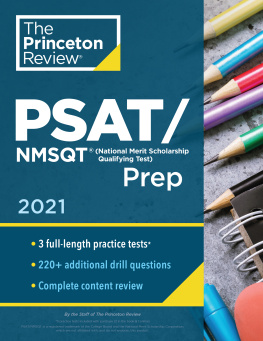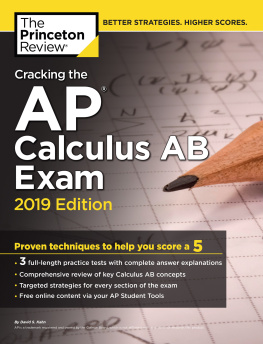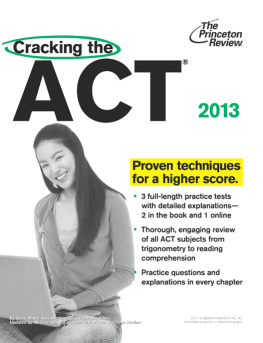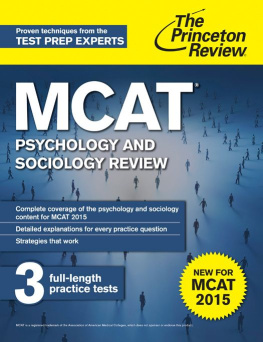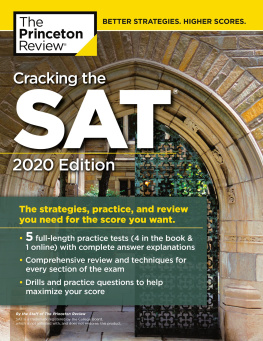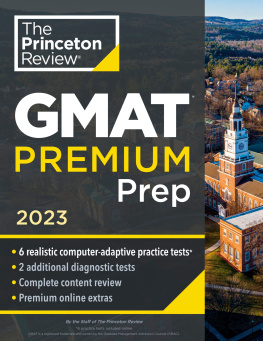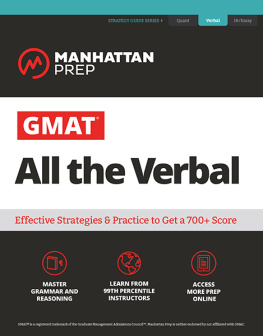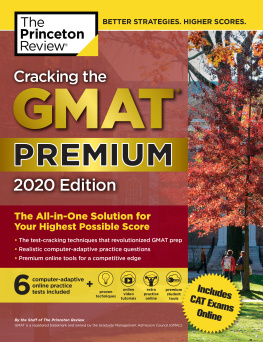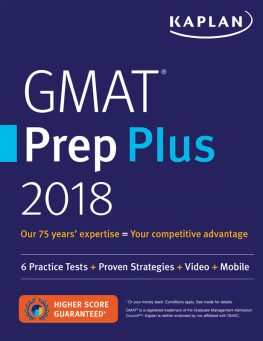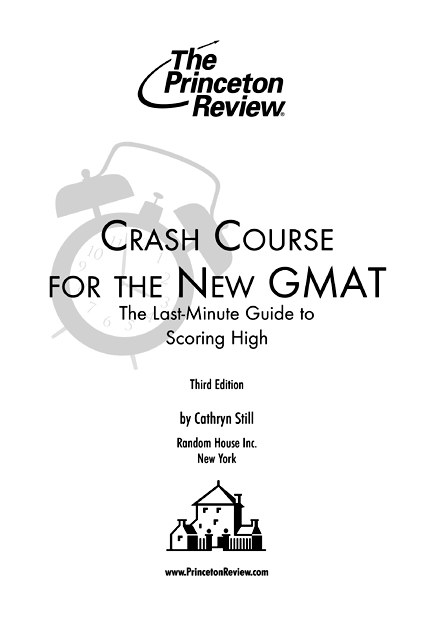The Princeton Review, Inc.
111 Speen Street
Framingham, MA 01701
E-mail:
Copyright 2012 by The Princeton Review Publishing, Inc.
Cover art Jonathan Pozniak
The Princeton Review is not affiliated with Princeton University.
All rights reserved. Published in the United States by Random House, Inc., New York, and in Canada by Random House of Canada Limited, Toronto.
eISBN: 978-0-307-94466-5
Editor: Calvin Cato
Production Editor: Kathy G. Carter
Production Coordinator: Deborah A. Silvestrini
Third Edition
v3.1
A CKNOWLEDGMENTS
The Princeton Reviews GMAT course, a primary source for this book, would not be the powerhouse it is without the help and guidance of these smart, committed people: Tim Wheeler, Dan Edmonds, Susan Baer, Jack Schieffer, and Magda Pecsenye. We would like to acknowledge the original team of teachers and developers who conceived and brought our first GMAT course to life: Alicia Ernst, Tom Meltzer, Paul Foglino, John Sheehan, Mark Sawula, Nell Goddin, Teresa Connelly, and Philip Yee. We also thank all the people involved in the production of this book: Maria Dente, Allegra Burton, Fritz Stewart, Jason Kantor, and Stephanie Martin.
A big round of applause goes out to our students: Your hard work and tough questions are the reasons we love what we do.
Finally, the author would like to personally thank her family and her sweetheart, David, for their love and support.
Special thanks to Adam Robinson, who conceived of and perfected the Joe Bloggs approach to standardized tests and many of the other successful techniques used by The Princeton Review.
C ONTENTS
O RIENTATION
WHAT IS A CRASH COURSE?
So the GMAT is coming up fast, and all your best intentions of studying an hour a day for the past three months have gone out the window. Not to worrytheres still hope. Crash Course for the New GMAT will give you an effective strategy for tackling the GMAT, even though youre down to the wire. After a brief overview of the format of the entire GMAT, well dive right into a 10-step study plan designed to give you the highest possible rate of return. Weve broken down each section by question type, and identified the best strategy for each type of question youll see on the exam. But Crash Course for the New GMAT is not a comprehensive study guide for the GMATif you have more time and thats what youre looking for, try The Princeton Reviews Cracking the New GMAT.
WHAT IS THE GMAT?
The Graduate Management Admissions Test (GMAT) is primarily intended to measure the aptitude of applicants to Masters of Business Administration programs. The test is not an indicator of intelligence, nor will it in any way predict your grades in business school or the likelihood that youll sell your start-up for $50 million three years out. Its just a measure of how well you perform on standardized tests.
The GMAT is made up of three parts:
- An Analytical Writing Assessment (AWA)
- An Integrated Reasoning section
- A multiple-choice section with two parts, Verbal and Quantitative (Math)
Analytical Writing Assessment
The Analytical Writing Assessment (AWA) is a 30-minute section during which you must develop an essay. The essay, called an Analysis of an Argument, requires you to critique the position of an author on a particular dilemma or argument. The test creators have developed a simple word-processing program that allows you to compose your essay on the computer screen.
Integrated Reasoning Section
The 30-minute Integrated Reasoning section consists of 12 items, each of which may consist of 3 to 5 questions. Overall, youll probably answer between 30 and 38 separate questions to finish the section. Items may contain charts or tables and may ask you to evaluate information from different sources. Most questions feel like math questions, but a few may also test your verbal abilities. The Integrated Reasoning section has four types of new items. At the time of this writing, the number of each type of item in the section is unknown. Be sure to check www.PrincetonReview.com for the latest information. The four new question types are as follows:
- Table Analysis
- Graphics Interpretation
- Multi-Source Reasoning
- Two Part Analysis
Multiple-Choice Section
The multiple-choice section of the GMAT has two subsections, Verbal and Quantitative (Math).
The 75-minute Verbal section consists of 41 multiple-choice questions, 11 of which are experimental (not scored). Well tell you more about the experimental questions later. In this section, youll see three types of questions (in no particular order):
- Reading comprehension (approximately 14 questions and 4 passages)
- Sentence correction (approximately 14 questions)
- Logical reasoning (approximately 14 questions)
The 75-minute Quantitative section of the GMAT contains 37 questions of two types (again, in no particular order):
- Problem solving (1822 questions)
- Data sufficiency (1519 questions)
WHO WRITES THE GMAT?
The GMAT is owned and sponsored by the Graduate Management Admission Council (GMAC), a nonprofit organization with a board composed of top administrators and deans who set the standards for admission to accredited business schools in the United States. The test itself is produced by ACT Inc. (which creates the ACT and develops test questions for a wide variety of standardized tests) and Pearson Vue, which distributes the exam to testing centers around the country.
HOWS IT SCORED?
Your GMAT scores will be broken down into three separate scores, one for the AWA, one for the Integrated Reasoning section, and one for the multiple-choice section of the test. The AWA essay is graded holistically on a scale of 0 (unintelligible) to 6 (well done).
At the time of this writing, GMAC had not released the scale or any other details about the scoring of the Integrated Reasoning section. Be sure to check our website, www.PrincetonReview.com, for the latest information about the Integrated Reasoning section.
Your performance on each multiple-choice section of the test generates a two-digit number, called the sectional subscore, ranging from 060. These subscores are combined into a three-digit number, called your composite, or overall, score. Overall scores range from 200800. The average (50th percentile) GMAT score is around 550, while a score of 700 would be in the 90th percentile.
Scores on the AWA, Integrated Reasoning, and multiple-choice portions of the exam are separatethey do not affect each other in any way.
EXPERIMENTAL QUESTIONS
Scattered throughout the Verbal and Quantitative sections of the test are approximately 18 questions that do not count toward your score. These are experimental, or research, questions, and their sole purpose is to generate data for GMAC. You will not recognize the experimental questions; they look and feel just like the real things. GMAC uses your performance on these questions to determine their viability and to generate scoring statistics on them.


